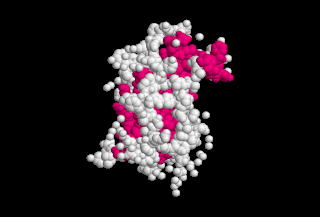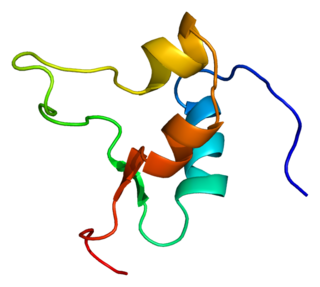
The insulin-like growth factors (IGFs) are proteins with high sequence similarity to insulin. IGFs are part of a complex system that cells use to communicate with their physiologic environment. This complex system consists of two cell-surface receptors, two ligands, a family of seven high-affinity IGF-binding proteins, as well as associated IGFBP degrading enzymes, referred to collectively as proteases.

Growth hormone (GH) or somatotropin, also known as human growth hormone in its human form, is a peptide hormone that stimulates growth, cell reproduction, and cell regeneration in humans and other animals. It is thus important in human development. GH also stimulates production of Insulin-like growth factor 1 (IGF-1) and increases the concentration of glucose and free fatty acids. It is a type of mitogen which is specific only to the receptors on certain types of cells. GH is a 191-amino acid, single-chain polypeptide that is synthesized, stored and secreted by somatotropic cells within the lateral wings of the anterior pituitary gland.

Bovine somatotropin or bovine somatotrophin, or bovine growth hormone (BGH), is a peptide hormone produced by cows' pituitary glands. Like other hormones, it is produced in small quantities and is used in regulating metabolic processes. Scientists created a bacterium that produces the hormone somatotropin which is produced by the cow's body after giving birth and increases milk production by around 10 percent.

Growth hormone deficiency (GHD), or human growth hormone deficiency, is a medical condition resulting from not enough growth hormone (GH). Generally the most noticeable symptom is that an individual attains a short height. Newborns may also present low blood sugar or a small penis size. In adults there may be decreased muscle mass, high cholesterol levels, or poor bone density.
Growth hormone therapy refers to the use of growth hormone (GH) as a prescription medication—it is one form of hormone therapy. Growth hormone is a peptide hormone secreted by the pituitary gland that stimulates growth and cell reproduction. In the past, growth hormone was extracted from human pituitary glands. Growth hormone is now produced by recombinant DNA technology and is prescribed for a variety of reasons. GH therapy has been a focus of social and ethical controversies for 50 years.

Insulin-like growth factor 1 (IGF-1), also called somatomedin C, is a hormone similar in molecular structure to insulin which plays an important role in childhood growth, and has anabolic effects in adults. In the 1950s IGF-1 was called "sulfation factor" because it stimulated sulfation of cartilage in vitro, and in the 1970s due to its effects it was termed "nonsuppressible insulin-like activity" (NSILA).

Insulin-like growth factor 2 (IGF-2) is one of three protein hormones that share structural similarity to insulin. The MeSH definition reads: "A well-characterized neutral peptide believed to be secreted by the liver and to circulate in the blood. It has growth-regulating, insulin-like and mitogenic activities. The growth factor has a major, but not absolute, dependence on somatotropin. It is believed to be a major fetal growth factor in contrast to insulin-like growth factor 1 (IGF-1), which is a major growth factor in adults."
Growth hormone–releasing hormone (GHRH), also known as somatocrinin or by several other names in its endogenous forms and as somatorelin (INN) in its pharmaceutical form, is a releasing hormone of growth hormone (GH). It is a 44-amino acid peptide hormone produced in the arcuate nucleus of the hypothalamus.
Tercica, Inc., was a biopharmaceutical company based in Brisbane, California, United States. It developed Increlex, also known as recombinant human Insulin-like Growth Factor-1 (rhIGF-1). Tercica applied to the Food and Drug Administration (FDA) for approval of Increlex as a long-term therapy for growth failure in children with severe primary IGF-1 deficiency, which is characterized by growth failure, and as a treatment for children with growth hormone (GH) gene deletion who have developed neutralizing antibodies to growth hormone.

The insulin-like growth factor 1 (IGF-1) receptor is a protein found on the surface of human cells. It is a transmembrane receptor that is activated by a hormone called insulin-like growth factor 1 (IGF-1) and by a related hormone called IGF-2. It belongs to the large class of tyrosine kinase receptors. This receptor mediates the effects of IGF-1, which is a polypeptide protein hormone similar in molecular structure to insulin. IGF-1 plays an important role in growth and continues to have anabolic effects in adults – meaning that it can induce hypertrophy of skeletal muscle and other target tissues. Mice lacking the IGF-1 receptor die late in development, and show a dramatic reduction in body mass. This testifies to the strong growth-promoting effect of this receptor.

Laron syndrome (LS), also known as growth hormone insensitivity or growth hormone receptor deficiency (GHRD), is an autosomal recessive disorder characterized by a lack of insulin-like growth factor 1 production in response to growth hormone. It is usually caused by inherited growth hormone receptor (GHR) mutations.
Mecasermin rinfabate, also known as rhIGF-1/rhIGFBP-3, is a drug consisting of recombinant human insulin-like growth factor 1 (IGF-1) and recombinant human insulin-like growth factor binding protein-3 (IGFBP-3) which is used for the treatment of amyotrophic lateral sclerosis.

Insulin-like growth factor-binding protein 3, also known as IGFBP-3, is a protein that in humans is encoded by the IGFBP3 gene. IGFBP-3 is one of six IGF binding proteins that have highly conserved structures and bind the insulin-like growth factors IGF-1 and IGF-2 with high affinity. IGFBP-7, sometimes included in this family, shares neither the conserved structural features nor the high IGF affinity. Instead, IGFBP-7 binds IGF1R, which blocks IGF-1 and IGF-2 binding, resulting in apoptosis.

Insulin-like growth factor-binding protein 7 is a protein that in humans is encoded by the IGFBP7 gene. The major function of the protein is the regulation of availability of insulin-like growth factors (IGFs) in tissue as well as in modulating IGF binding to its receptors. IGFBP7 binds to IGF with low affinity compared to IGFBPs 1-6. It also stimulates cell adhesion. The protein is implicated in some cancers.

Insulin-like growth factor binding protein, acid labile subunit, also known as IGFALS, is a protein which in humans is encoded by the IGFALS gene.
CJC-1295, also known as DAC:GRF, is a synthetic analogue of growth hormone-releasing hormone (GHRH) and a growth hormone secretagogue (GHS) which was developed by ConjuChem Biotechnologies. It is a modified form of GHRH (1-29) with improved pharmacokinetics, especially in regard to half-life.

Ibutamoren is a potent, long-acting, orally-active, selective, and non-peptide agonist of the ghrelin receptor and a growth hormone secretagogue, mimicking the growth hormone (GH)-stimulating action of the endogenous hormone ghrelin. It has been shown to increase the secretion of several hormones including GH and insulin-like growth factor 1 (IGF-1) and produces sustained increases in the plasma levels of these hormones without affecting cortisol levels.
Long arginine 3-IGF-1, abbreviated as IGF-1 LR3 or LR3-IGF-1, is a synthetic protein and lengthened analogue of human insulin-like growth factor 1 (IGF-1). It differs from native IGF-1 in that it possesses an arginine instead of a glutamic acid at the third position in its amino acid sequence, and also has an additional 13 amino acids at its N-terminus (MFPAMPLLSLFVN) ("long"), for a total of 83 amino acids. The consequences of these modifications are that IGF-1 LR3 retains the pharmacological activity of IGF-1 as an agonist of the IGF-1 receptor, has very low affinity for the insulin-like growth factor-binding proteins (IGFBPs), and has improved metabolic stability. As a result, it is approximately three times more potent than IGF-1, and possesses a significantly longer half-life of about 20–30 hours.
des(1-3)IGF-1 is a naturally occurring, endogenous protein, as well as drug, and truncated analogue of insulin-like growth factor 1 (IGF-1). des(1-3)IGF-1 lacks the first three amino acids at the N-terminus of IGF-1. As a result of this difference, it has considerably reduced binding to the insulin-like growth factor-binding proteins (IGFBPs) and enhanced potency relative to IGF-1.
A bone growth factor is a growth factor that stimulates the growth of bone tissue.









